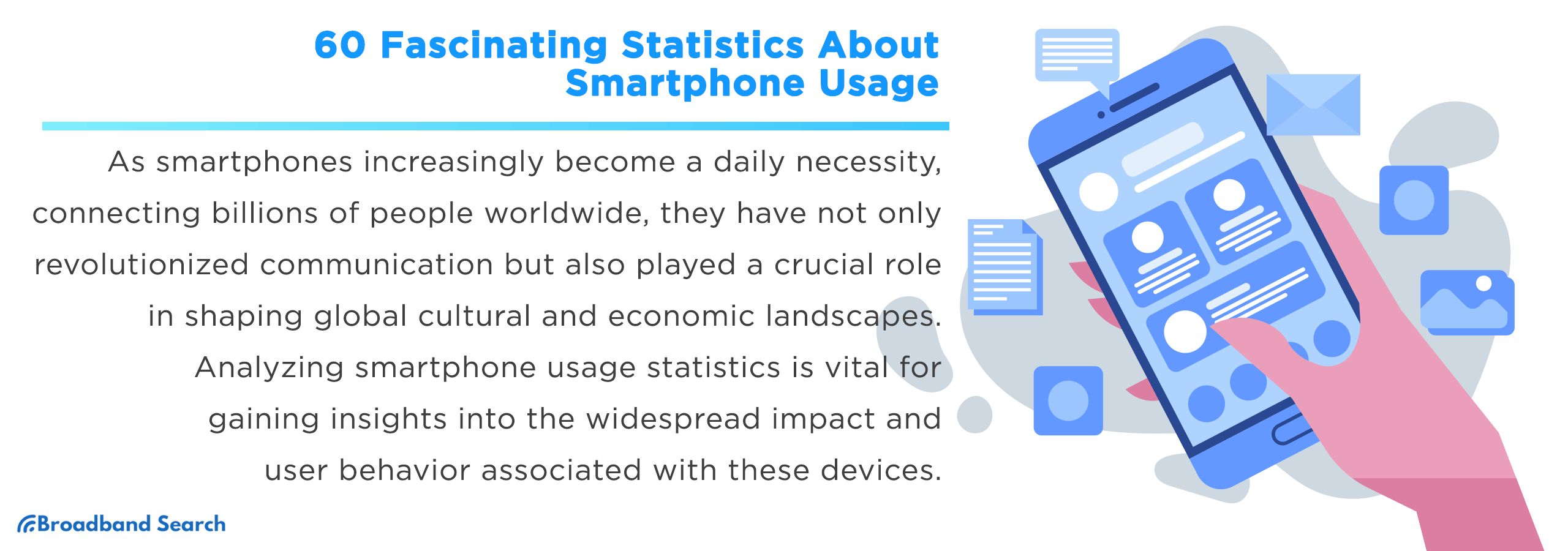We rely more on smartphones each day. These devices, once a luxury, have now become a necessity, connecting billions of people via mobile networks. With such widespread adoption, smartphones have not only transformed how we communicate but have also become integral in shaping cultural and economic landscapes worldwide.
Yet how do people use them? Which people use them most? Understanding smartphone usage statistics is crucial, as the numbers offer insights into the expansive reach of these devices and general user behavior.
Brief History of Smartphone Evolution
The evolution of the smartphone stands as a testament to human ingenuity. From the first call made on a bulky prototype in the early 70s, the development arc of the smartphone has bent towards increasing miniaturization, power, and versatility. Let’s go over some key milestones in smartphone development.
- 1973 — Mobile Cellular Phone Prototype Developed: Motorola's Dr. Martin Cooper invented the first mobile phone prototype, making the inaugural call to Bell Labs' Joel Engel in New York and igniting the mobile revolution.
- 1983 — Motorola DynaTAC 8000X Launches: The first consumer mobile phone, the Motorola DynaTAC 8000X, received FCC approval. It weighed 2 pounds, offered 30 minutes of talk time, and cost $3,995.
- 1991 — Advent of 2G: Finland introduced 2G on GSM networks.
- 1991 — Lithium-Ion Batteries: Sony and Asahi Kasei released the rechargeable lithium-ion battery, still prevalent in today's smartphones.
- 1992 — First Smartphone and SMS: IBM's Frank Canova showcased the prototype "smartphone," and Neil Papworth sent the first SMS, stating "Merry Christmas."
- 1994 — IBM Simon Hits the Market: The IBM Simon Personal Communicator became the first smartphone sold to consumers, featuring a touchscreen and preloaded apps, priced at $1,099.
- 1997 — 'Smartphone' Coined: Ericsson termed its GS88 as a "smartphone."
- 1999 — Camera Phones and GPS Integration: Japan's Kyocera VP-210 became the first camera phone with emailing capability. Benefon Esc introduced commercial GPS technology in phones.
- 2000 — Back-facing Camera Phone Introduced: Sharp's J-SH04, released in Japan, became the first mass-market phone with a rear-facing camera.
- 2001 — 3G Networks Emerge: Mobile phones began accessing the internet through 3G networks, marking the start of widespread mobile internet adoption.
- 2004 — Enhanced Live-assisted GPS Technology: Qualcomm improved live location accuracy with its live-assisted GPS technology.
- 2007 — Apple's First iPhone: Apple launched the first iPhone, which sold over 1.4 million units in the first year.
- 2008 — First Android Smartphone Released: The T-Mobile G1, also known as HTC Dream, was the first Android smartphone.
- 2009 — 4G Network Introduction: Telia Sonera offered the first 4G network, significantly faster than 3G and revolutionizing mobile data speeds.
- 2019 — First 5G Network by Verizon: Verizon launched the world's first 5G network in Chicago and Minneapolis, heralding a new era of mobile connectivity.
Global Smartphone Penetration
Today, smartphones are a global phenomenon, showcasing a shift in lifestyle and communication for most of the world’s population. This widespread adoption has spurred social and economic changes, bridged gaps between different societies, and empowered individuals with access to more information and services than they might have previously thought possible.
Overall Market Growth
Predictions for the global smartphone user base indicate a steady rise from 2024 to 2028, with an addition of approximately 496.7 million users, marking an increase of 10.71 percent.
It's important to note that these figures pertain specifically to internet users of any age who access the internet via a smartphone. The data presented has been extrapolated from survey responses, with calculated estimations to account for demographic segments not directly surveyed.
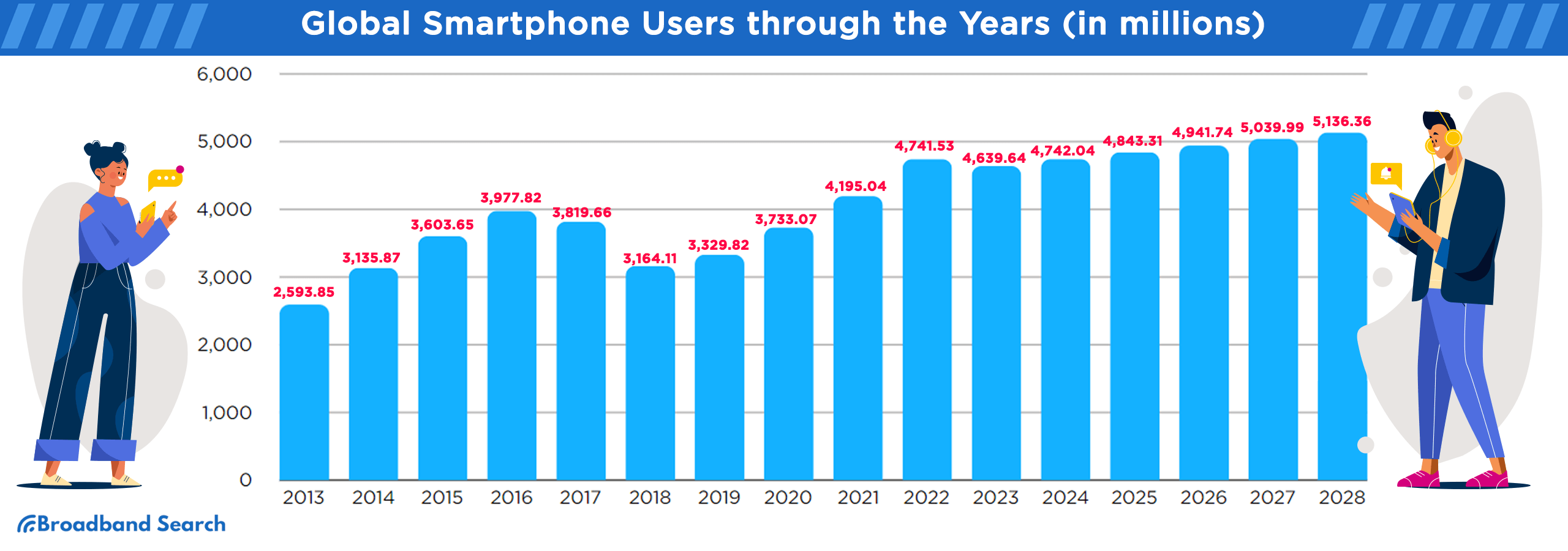
Key Trends in the Global Smartphone Market
- Samsung and Apple Dominance: Samsung led the global smartphone market by shipments in Q3 2023, closely followed by Apple, with both brands consistently vying for the top position.
- Rising Competitors and Shifting Dynamics: Xiaomi firmly held the third spot with a 13.7 percent market share, while Huawei, once a major player, fell out of the top five due to competitive pressures and the U.S. trade ban.
- Market Recovery and Cyclical Sales: Samsung's recovery from the pandemic saw nearly 258 million units shipped in 2022, while Apple shipped over 225 million iPhones, with sales peaking in the fourth quarter annually.
Smartphone User Counts: Top Countries Dominating the Market in 2022
In 2022, a diverse array of countries emerged as frontrunners in the mobile market. Leading the charge is China with an impressive 974.69 million users.
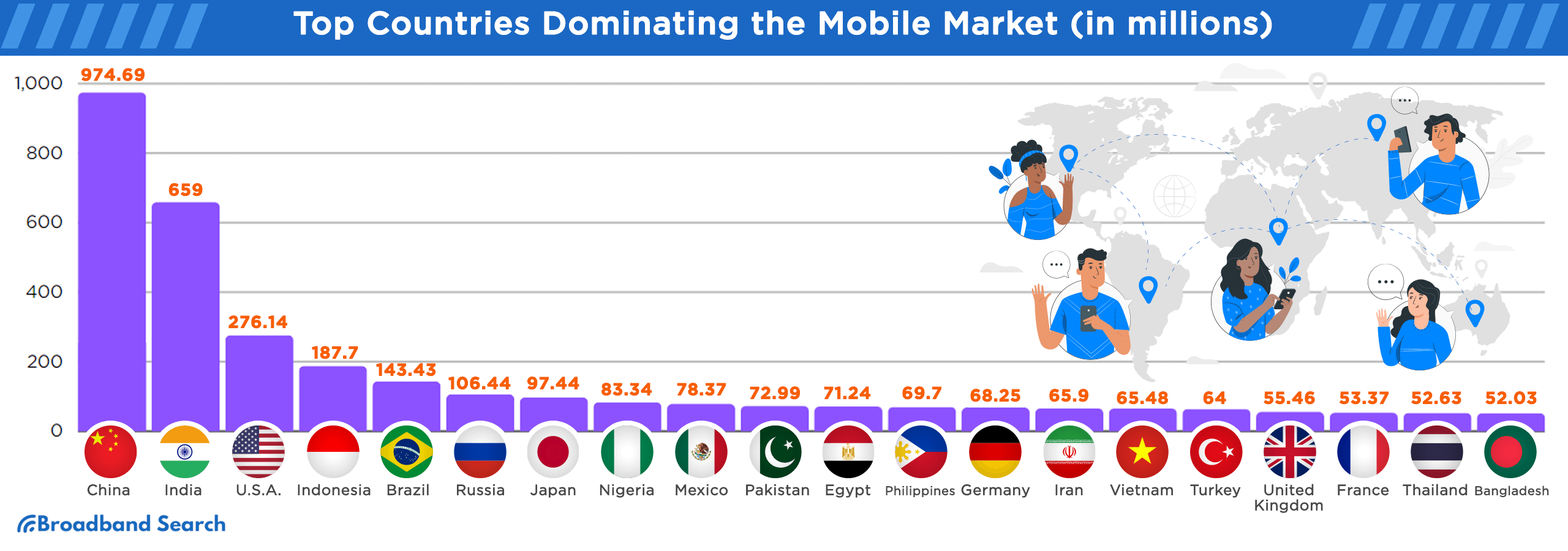
Demographics of Smartphone Users
The number of smartphone users varies significantly from one demographic to another, painting a complex portrait of global connectivity.
Age Distribution in the US
In the United States, the smartphone market presents a fascinating tapestry of brand allegiance across different age groups. The distribution of iPhone versus Android users among American adults reveals varied preferences that tend to align with generational trends.
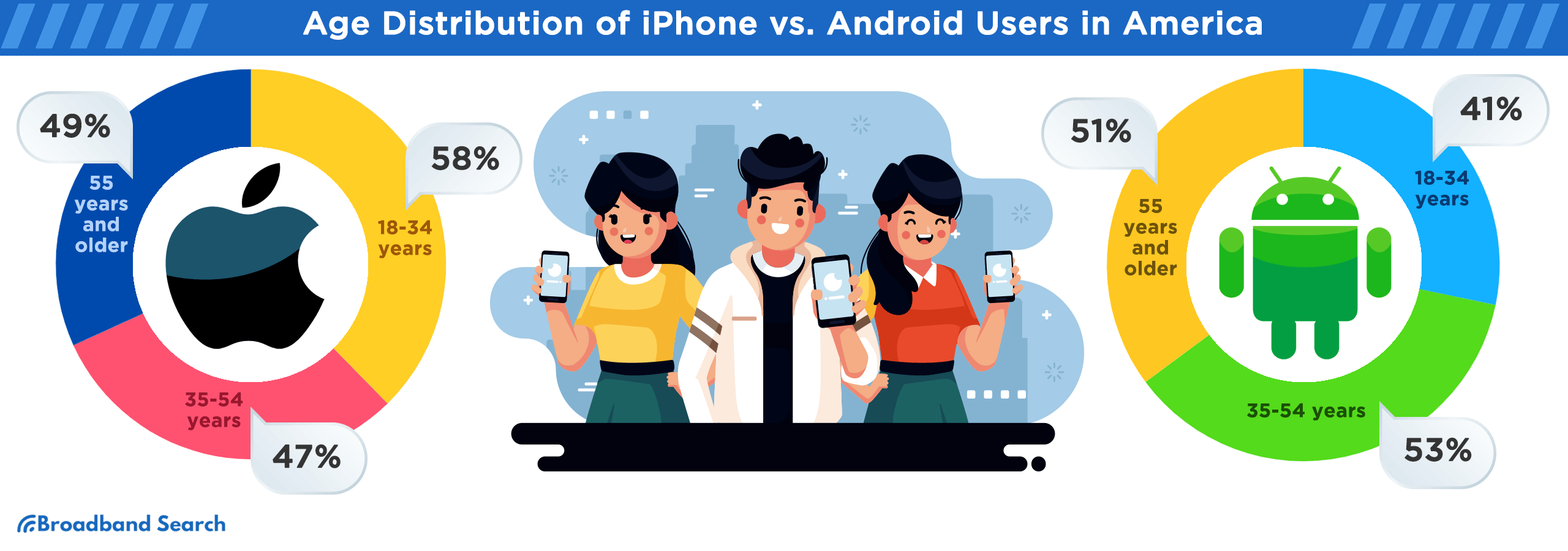
Smartphone Usage By Generation
Different generations exhibit distinct patterns in smartphone usage, reflecting varying attitudes, needs, and technological fluency.
- Millennials: Smartphone penetration reaches a high of 94 percent among millennials.
- Gen X: A report by GlobalWebIndex reveals that individuals from Generation X typically dedicate around two and a half hours each day to smartphone use, with about two hours of this time spent on social media.
- Gen Z: Generation Z, often termed "digital natives" and under 25 years old, have been raised with smartphones and the internet. They make up nearly 40 percent of mobile users and are predominant consumers of video content. According to an IBM study, Gen Zers typically use up to five screens, including smartphones, tablets, laptops, TVs, and desktops, with 75 percent preferring smartphones as their primary device.
- Gen Alpha: Nearly two-thirds of Generation Alpha individuals possess a smartphone by the age of 10, and according to Ofcom data, 39 percent of children as young as three or four years old are already using mobile phones for internet access.
- Baby Boomers: Marketing Dive highlights that 65.6 percent of Baby Boomers, aged between 57 and 75, own smartphones. This generation predominantly engages with apps that enhance their quality of life, focusing on those offering information about healthy living, shopping, and travel.
Socio-economic Impact
Smartphones act as gateways to educational resources, economic opportunities, and enhanced connectivity, yet their impact varies across different socio-economic strata. Penetration rates differ among household income groups, and how people use smartphones differs as well.
Percentage of U.S. Adults Owning Smartphones Based on Household Income
In the United States, the correlation between household income and smartphone ownership is evident. As income levels increase, so does the likelihood of owning a smartphone.
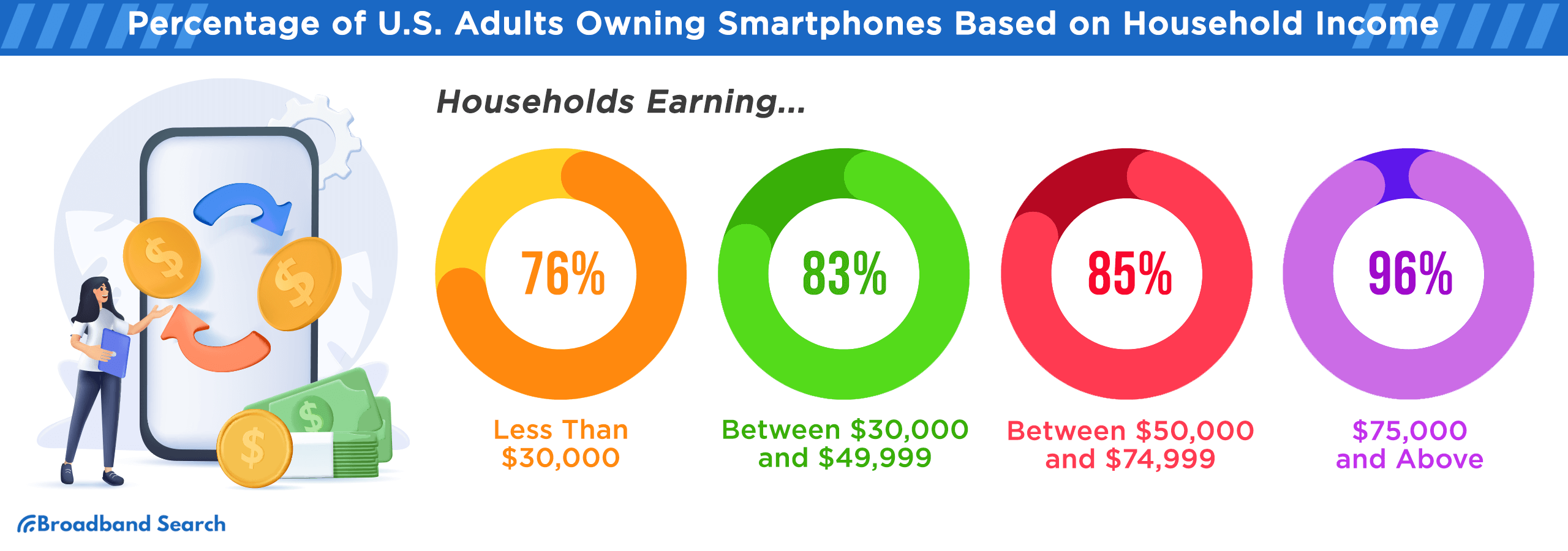
Geographic Variations in Smartphone Usage Across the United States
- Urban residents show the highest usage rate at 83 percent.
- Suburban areas have a slightly lower usage rate of 78 percent.
- Rural regions lag at 65 percent.
Gender Divide
There is a subtle difference between men and women regarding smartphone ownership.
- Female ownership: 97 percent of U.S. women aged 16-64 own smartphones.
- Male ownership: 95 percent of U.S. men possess smartphones.
Smartphone Usage Habits
Examining smartphone usage habits reveals much about our digital behaviors and preferences. To understand current trends, it’s essential to look at daily usage, the most popular apps, and screen time averages.
Daily Usage Statistics
Research indicates that 6.3 percent of the global population exhibits smartphone addiction. On average, Americans spend about 7 hours and 4 minutes daily on screen time. This figure rises among college students in the United States, with an average daily smartphone use ranging between 8 to 10 hours.
Global Trends: Leading Activities Among Smartphone Users Worldwide
From communication to entertainment (among other things), how users engage with their smartphones are varied and telling.
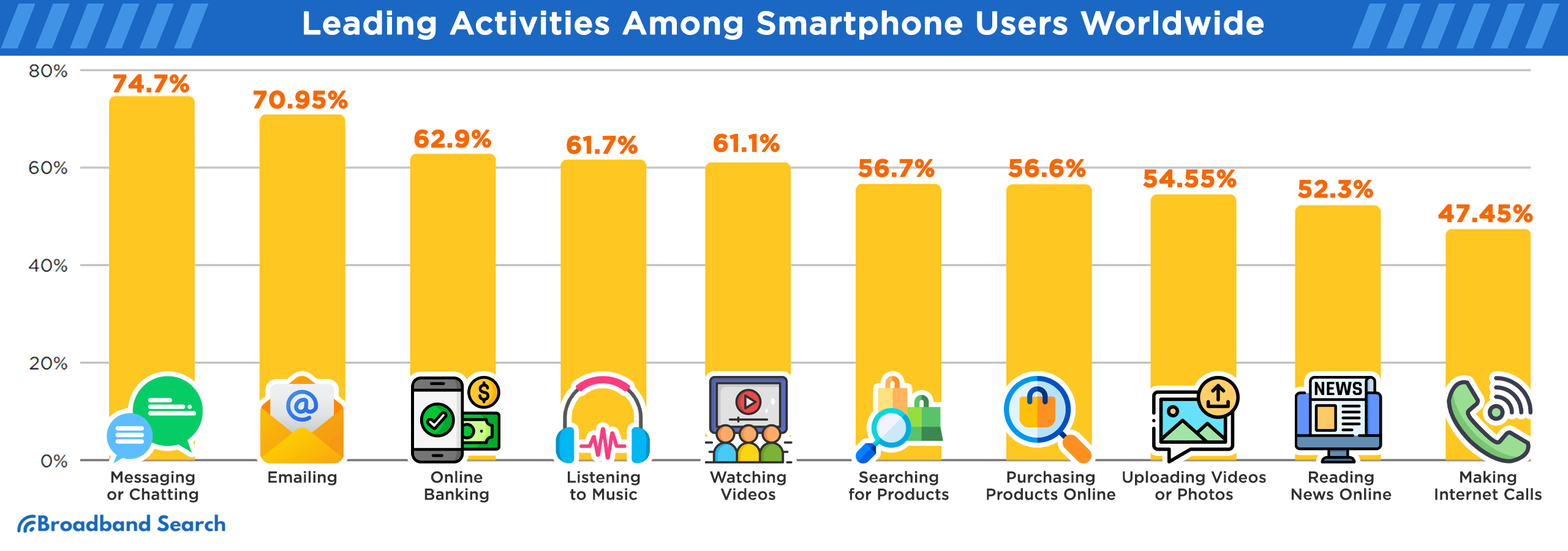
App Usage and Popularity
Understanding the patterns of app usage and popularity is imperative to grasp how smartphones shape our digital behavior and preferences. With millions of apps available, users' choices can reveal much about current trends, needs, and interests.
Most Popular Apps (Global)
In 2022, TikTok maintained its position as the most downloaded app globally and saw its video editing app, CapCut, enter the top five. Meta’s strong presence was marked by having three of its apps in the top five, showcasing the enduring popularity of its platforms.
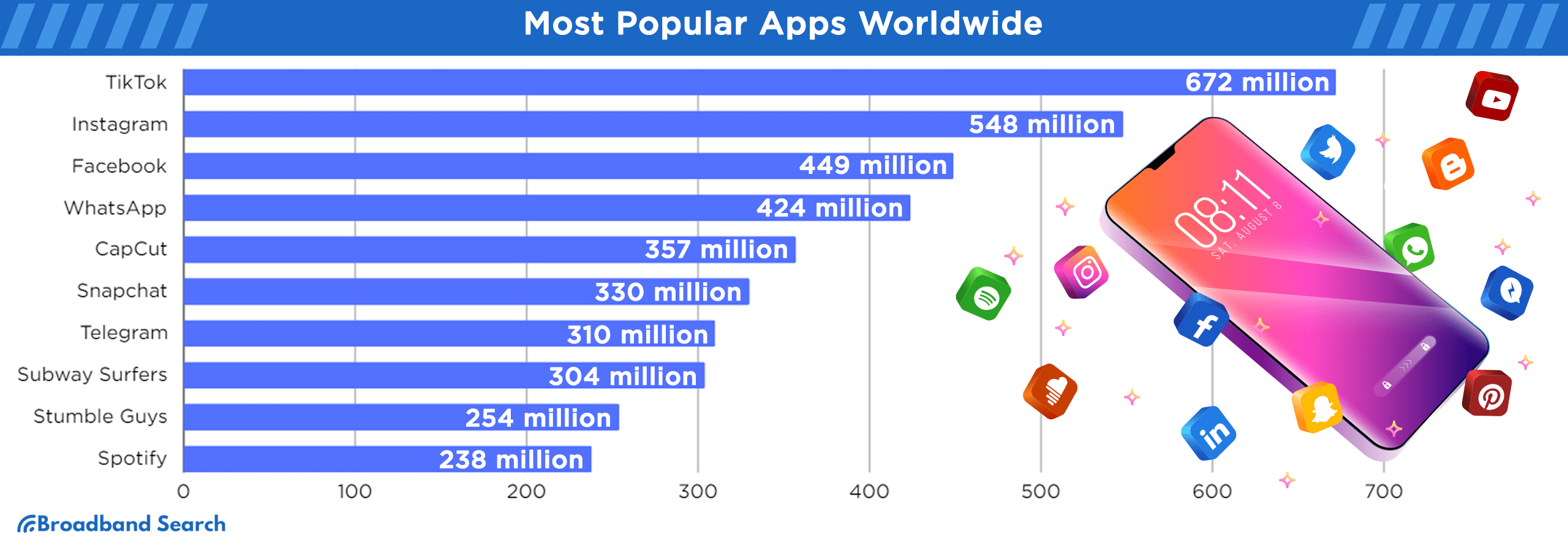
Most Popular Apps 2022 (United States)
In the U.S., TikTok remained the frontrunner, increasing in downloads for the second consecutive year. Cash App also saw a notable rise, securing its spot as the most downloaded finance app in the country.
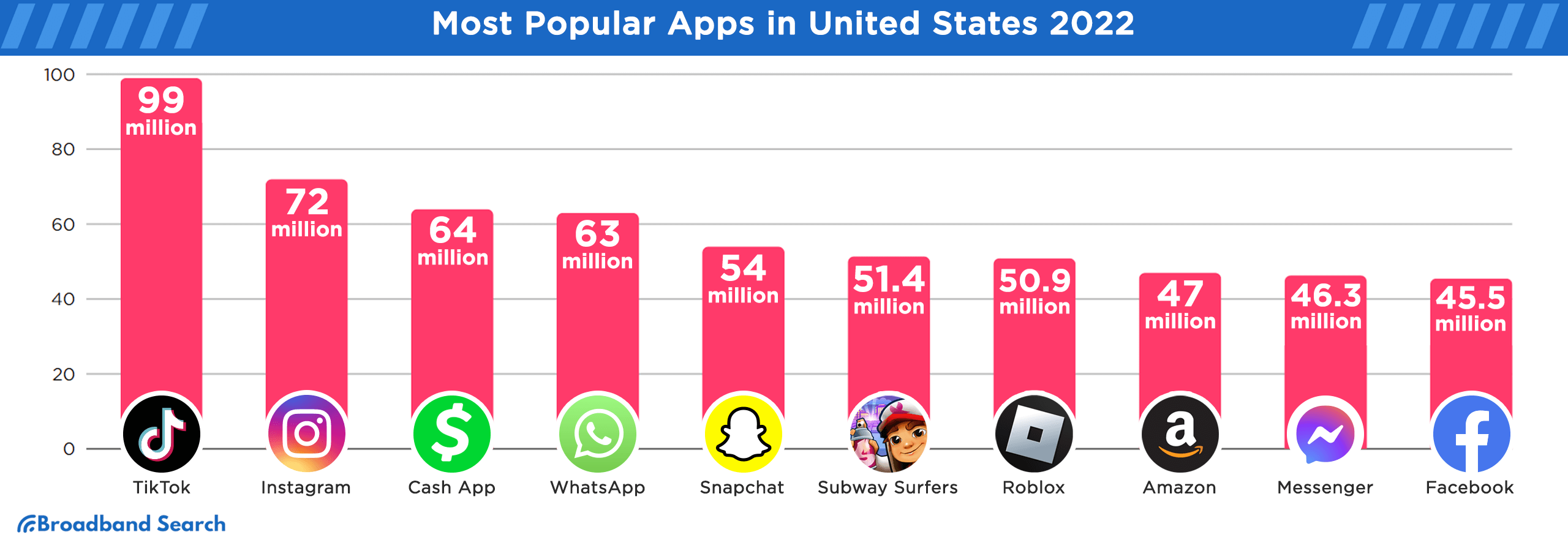
Browser vs. App Preference
Recent statistics reveal a significant preference for mobile apps over browsers, with 91.9 percent of digital time spent on apps and games compared to just 8.1 percent of time on browsers.
Consumers' preference regarding e-commerce is increasingly leaning towards using apps. They stand out with user-friendly interfaces and smooth transaction processes, catering to the modern shopper's need for convenience and ease.
In contrast, browser usage, though still relevant for specific tasks, is less prevalent, possibly owing to its more general and less personalized approach.
Impact of Smartphones on Daily Life
Regarding communication practices, smartphones have allowed the move from traditional voice calls to messaging apps and increasing video calling. In the professional sphere, smartphones have become indispensable for remote work and productivity with the help of productivity apps. For leisure, streaming services and mobile gaming have become increasingly popular.
Communication Patterns
Since the advent of smartphones and the rapid proliferation of mobile apps, low-cost or free chat and social messaging apps have emerged as a popular and economical alternative to traditional operator-based text messaging via SMS. Going beyond standard texting, users can engage in group chats, share images and videos, send audio messages, and more.
The convenience and versatility of messaging apps have contributed significantly to their popularity. As a result, people (especially young people) eschew calling in favor of the quick and expressive nature of messaging apps.
Percentage of Global Internet Users Who Made Video Calls on Their Mobile Phones
In the second quarter of 2023, a notable percentage of users turned to mobile phones for video calling.
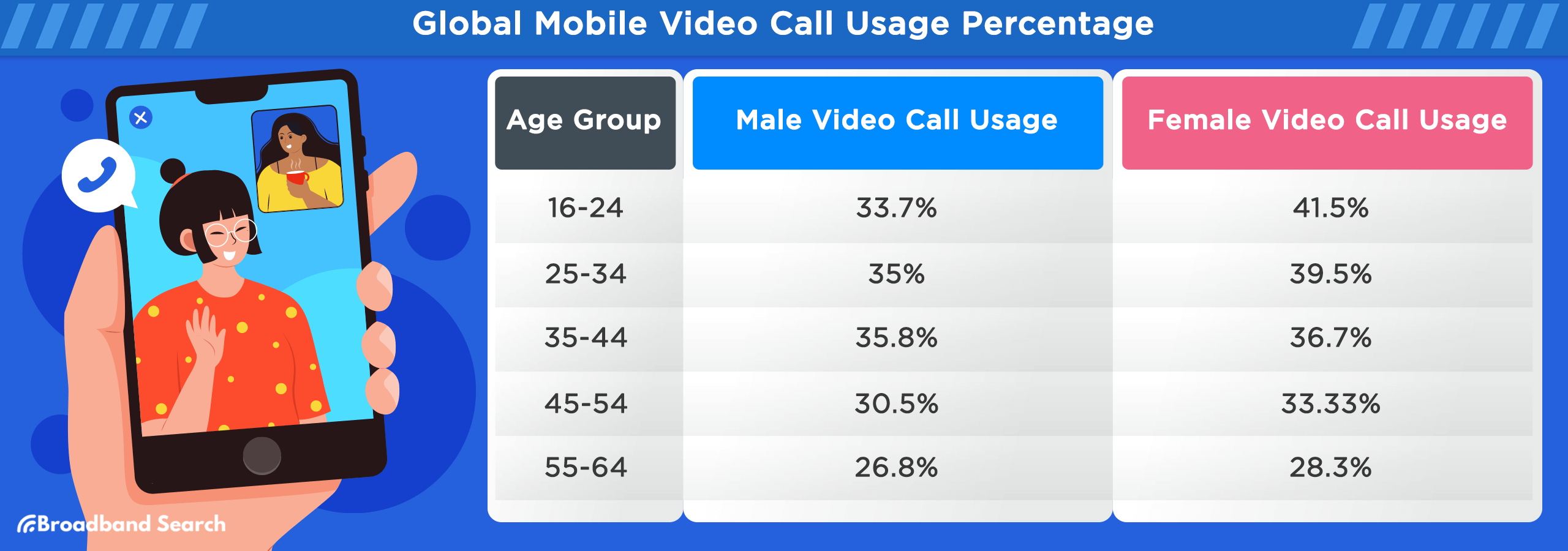
Smartphones in Work and Productivity
People are increasingly recognizing the potential for mobile devices to enhance employee productivity. A study published in September 2022 in an open-access journal supported the view that bring-your-own-device (BYOD) policies can positively impact productivity. The authors pointed out that hesitancy in adopting BYOD often results in reduced productivity.
Historical data corroborates this. A 2013 Dell survey involving 1,500 IT decision-makers revealed that two-thirds noticed a productivity boost post-BYOD implementation. Additionally, members of the Society for Industrial and Organizational Psychology have observed that personal device usage at work can improve employee well-being, enhancing productivity.
Leisure and Entertainment
Smartphones have profoundly altered the landscape of leisure and entertainment, with more people using smartphones due to increased functionality. Let’s delve into the significant trends in video streaming and mobile gaming that highlight this transformative shift.
- Video Streaming Preferences: As of March 2023, about 70 percent of the U.S. audience favored smartphones over smart TVs (59 percent) for digital video content. In North America, smartphones accounted for 16 percent of total video streaming time.
- Diverse Content on Mobile: A wide range of video content, from social media to fitness apps and streaming services, is available to U.S. mobile users. As of June 2023, YouTube reached 74 percent of mobile audiences, and TikTok reached 38 percent.
- Streaming Service Accessibility: Major platforms like Netflix, Hulu, and Amazon Prime Video have launched mobile apps, enhancing on-the-go access.
- Mobile Gaming Growth: Mobile games constituted 45 percent of the global video gaming revenue in 2022. The U.S. mobile gaming market reached $41.7 billion in revenue, with a significant user increase driven by technological advancements and COVID-19 lockdowns. Mobile gaming revenue is projected to surpass $100 billion globally by 2023.
The Economic Side of Smartphone Usage
Have you ever wondered how smartphone usage impacts the economy? Beyond their role as communication tools, smartphones have become powerful economic engines. Their widespread adoption and use have spawned entire industries, reshaped existing ones, and altered consumer spending habits.
From the direct costs of purchasing and maintaining these devices to the broader implications for advertising, e-commerce, and the app economy, the economic footprint of smartphone usage is vast and multifaceted.
Consumer Spending on Smartphones
Consumer spending on smartphones is a key measure of economic and technological trends, encompassing the purchase of the devices and the continued expenditure on related services and upgrades.
As smartphones become increasingly integral to daily life, analyzing spending patterns reveals how people regard and use these devices.
Average Smartphone Prices in the U.S. (2022-2027)
The data below highlights a trend of increasing prices for consumer smartphones while enterprise prices show a gradual decrease over the same period.
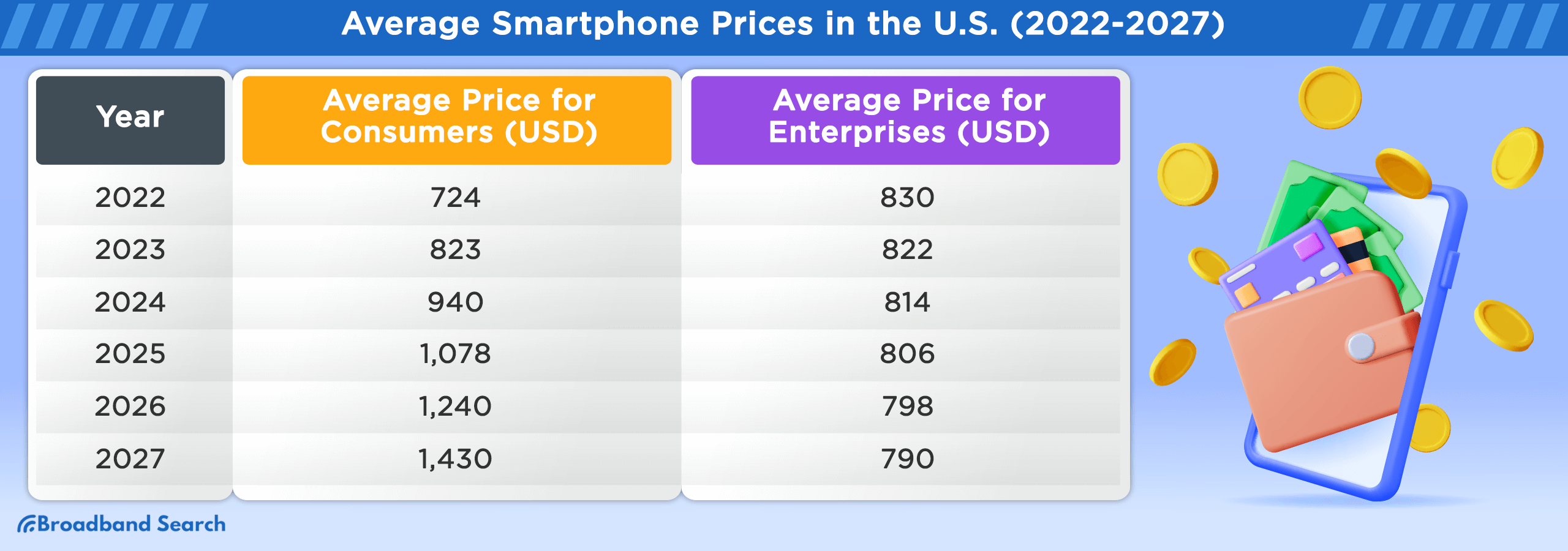
Average U.S. Consumer Expenditure on Mobile Apps Per Smartphone (2022-2023)
Exploring the spending habits of smartphone users, especially concerning mobile apps, reveals intriguing insights into consumer behavior. Consider the average expenditure on mobile apps per smartphone as shown below:
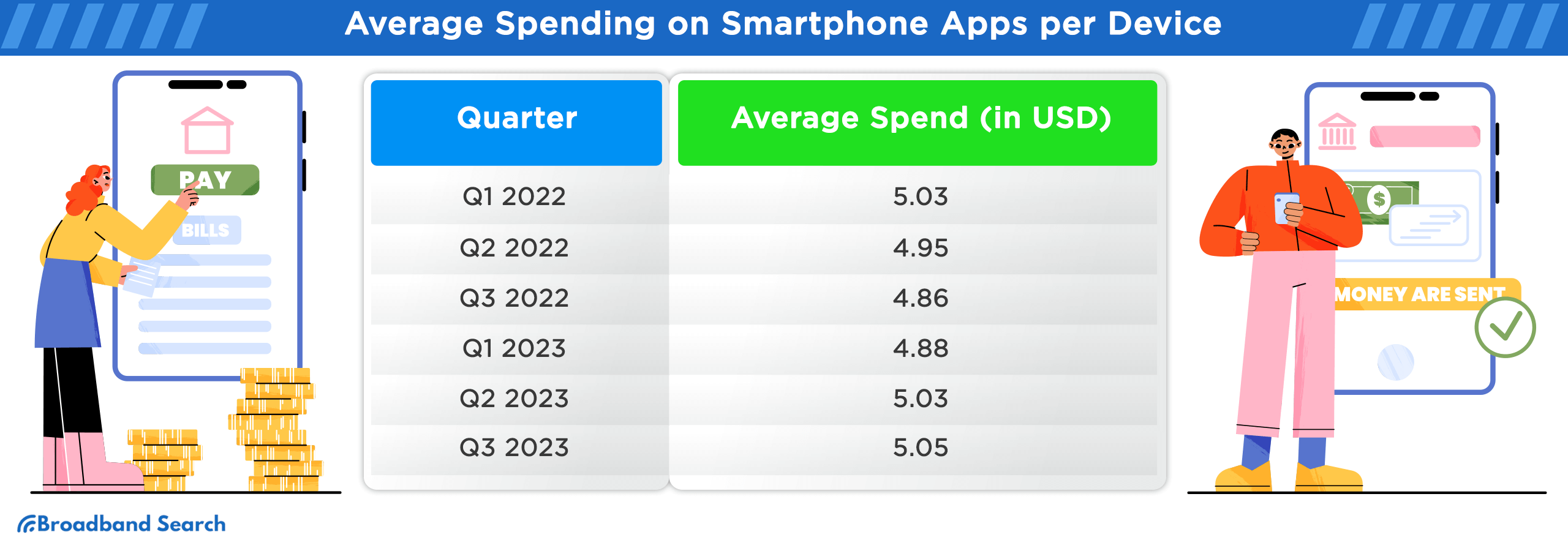
Advertising and Marketing
Mobile devices, now central to communication, news, and entertainment, have surpassed desktops as the primary internet access point globally, fueling their use in marketing.
In 2022, the worldwide mobile marketing market was valued at approximately $327 billion and projected to hit $400 billion by 2024. Mobile advertising spending is seeing yearly double-digit growth, especially in the U.S., the world's leading mobile ad market. In 2022, global mobile ad spending reached $327.1 billion, a 17.2 percent increase from the previous year, with expectations to approach $399.6 billion by 2024.
The Second-hand and Refurbished Smartphone Market
The global market for refurbished and used mobile phones is projected to experience considerable growth from 2022 to 2033. The sector is projected to grow to nearly $172 billion by 2033 from $50.5 billion in 2022, with a compound annual growth rate of 11.9 percent.
Consumer attitudes towards these devices show a nuanced perspective. A significant 66 percent of respondents to a U.S. survey were hesitant to buy refurbished smartphones. About 24 percent preferred only new devices. However, 14 percent of the survey participants would consider a refurbished phone if its quality met their standards.
Smartphone Connectivity and Technology
Smartphones are becoming pivotal in providing internet access. Mobile network development, particularly the widespread adoption of 4G and the emerging 5G networks, allows more people to access high-speed internet than ever before.
In terms of hardware, continuous advancements are seen in screen size, battery longevity, camera technology, and the introduction of innovative features like foldable screens.
Internet Access
Based on Statista's data from the second quarter of 2023, 95.8 percent of global users accessed the internet via mobile phones, and over 93 percent did so through smartphones. It is expected that smartphones will be the access point of choice for billions moving forward.
Mobile Networks Evolution
As the smartphone market matures and groundbreaking innovations become less frequent, the transition to 5G emerges as a key growth catalyst for the industry.
The GSMA notes a rapid adoption of this wireless standard, with 5G connections expected to reach one billion this year, yet there's significant potential for further growth.
In 2021, 5G comprised eight percent of global mobile connections, a figure set to rise to 25 percent by 2025, though 4G will continue to dominate with 55 percent of connections. Greater China leads in 5G adoption with 29 percent, followed by North America at 13 percent and Europe at four percent. By 2025, 5G is projected to become the leading standard in Greater China and North America, while the rest of the world will still largely depend on 4G.
Top 5 Countries with the Highest Average Mobile Internet Speeds
Qatar boasted the world's fastest average mobile internet speed, approaching an impressive 190 Mbps. Closely trailing were the United Arab Emirates (UAE) and Macau, both recording median rates surpassing 170 Mbps, positioning them among the top countries regarding mobile internet velocity.
- Qatar: 189.98 Mbps
- United Arab Emirates: 175.34 Mbps
- Macau (SAR): 171.73 Mbps
- Kuwait: 139.03 Mbps
- Norway: 131.16 Mbps
Smartphone Hardware Trends
Smartphone hardware constantly evolves, with notable trends in larger screen sizes, extended battery life, and advanced camera technology. Additionally, innovative technologies like foldable screens are gaining traction, with predictions suggesting they could constitute nearly 10 percent of all smartphone sales by 2030.
Preferences in Foldable Smartphone Market: Survey Insights
- General Preference for Foldables: 28 percent of current smartphone users show a strong likelihood to choose a foldable smartphone next.
- Brand Preference: Samsung is favored by 46 percent for foldables, followed by Apple (39 percent) and Motorola (6 percent). Samsung users display high brand loyalty with 92 percent preferring to stay with Samsung for a foldable purchase.
- Design Preference: The flip-type foldable is preferred by 49 percent of survey respondents, with a higher preference among male respondents. The book-type design is more popular among female respondents (40 percent vs. 30 percent for males).
- Income Influence: Individuals with a monthly income of $10,000 or more are the most inclined (41 percent) to purchase a foldable phone.
Smartphone Security and Privacy
The security and privacy of smartphones are critical in today's digital era, as they hold extensive personal and sensitive data. Protecting these devices from cyber threats and unauthorized access are vital concerns. Both individuals and organizations must understand and tackle these challenges, given the severe implications of security breaches.
Awareness and Concerns
The widespread use of smartphones has brought to light the crucial role of privacy and security settings. However, their usability is poorly understood, especially for socio-economically disadvantaged and less tech-savvy individuals. A survey of 178 users revealed a general lack of awareness about these privacy and security settings, including their default configurations.
Another study found that 92 percent of mobile users worry about malware applications. Nowadays, most mobile users assume their devices are secured against malware right from purchase. This is not always the case.
Incidence of Security Breaches
T-Mobile has recently faced another data breach, reported by Bleeping Computer, affecting just over 800 customers, a stark contrast to the massive breach in January impacting millions. The latest incident, which took place between February 24 and March 30, led to the theft of names, driver's licenses or ID numbers, and possibly other sensitive information like account PINs and Social Security numbers.
This series of breaches, particularly in light of Cybint's report that 95 percent of cybersecurity breaches stem from human error, highlights a growing trend in security incidents, with an 11 percent increase since 2018 and a 67 percent increase since 2014. This only shows the need for better cybersecurity and device security measures.
Mobile Device Security Threats: Attack Trends
The table below outlines the number of malware, adware, or unwanted software attacks on mobile devices, which saw a resurgence in Q2 2023. During this quarter, Kaspersky's products successfully blocked 5,700,000 such attacks.
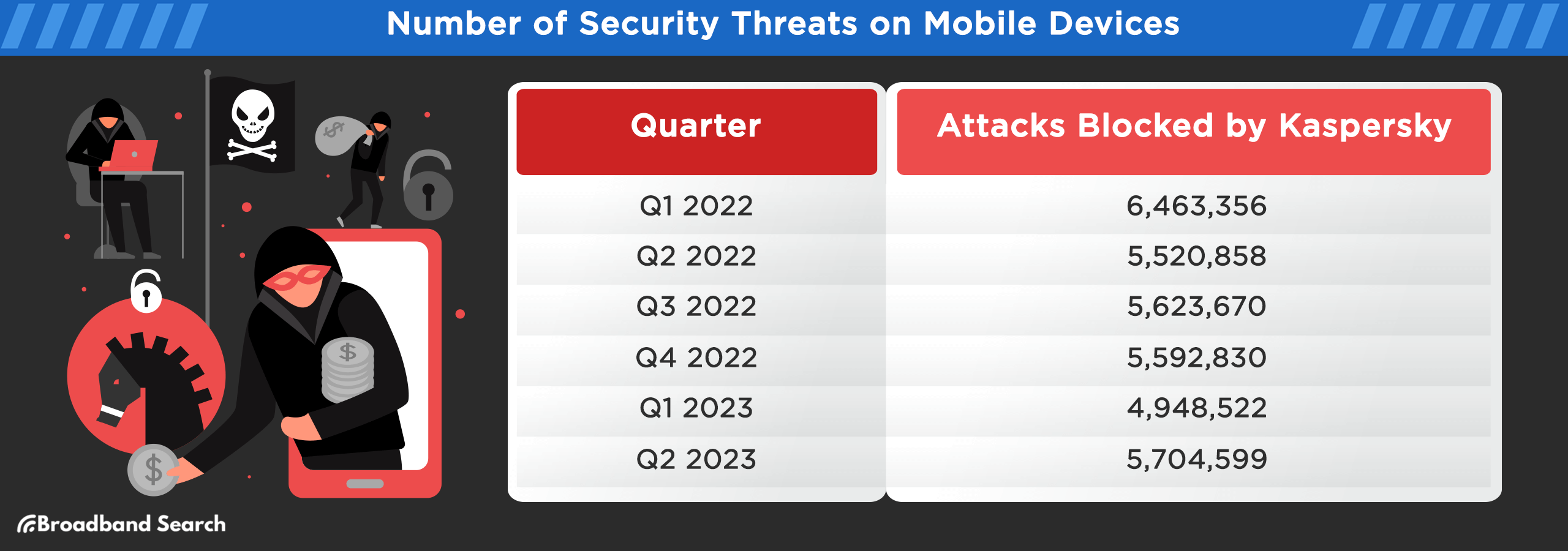
Adoption of Security Measures
The use of security features on mobile devices has become increasingly important. A survey conducted between October and November 2021 revealed that around 32 percent of respondents secured their mobile devices with a PIN or passcode, an essential yet crucial security measure. An equal proportion utilized fingerprint recognition, highlighting the growing preference for biometric security. Additionally, 15 percent of those surveyed chose passwords as their screen lock method.
Environmental Impact of Smartphone Usage
Do smartphones, which have become virtually indispensable in our daily lives, come with an environmental cost? As we increasingly rely on these devices for communication, work, and entertainment, it's essential to consider the environmental implications of their widespread use. From the resources used in their production to the challenges posed by electronic waste at the end of their lifecycle, the environmental impact of smartphone usage is a multifaceted issue.
Carbon Footprint
People often overlook the environmental impact of their smartphones, even as they use these devices to advocate for sustainability and recycling on social media. In 2020, the lifecycle of smartphones, including their production, use, and disposal, contributed to a staggering 580 million tons of CO2 emissions.
The broader ICT sector, which includes personal computers, laptops, smartphones, tablets, and digital infrastructure like data centers and networks, is projected to make up 14 percent of the global carbon footprint by 2040. This is set to exceed over half the emissions of the global transportation sector.
E-Waste and Recycling
A significant environmental issue with smartphones arises from their disposal post-lifespan. Consumers frequently replace their old but functional phones with the latest models in a society driven by rapid technological progress and changing trends.
Specifically, a pressing problem generated by this trend is electronic waste (e-waste), with less than 16 percent of smartphones getting recycled annually and many valuable materials ending up in landfills.
Risks Associated with Smartphone Usage
The ubiquitous use of smartphones, while offering unparalleled convenience and connectivity, also brings a spectrum of potential risks and challenges. From health concerns stemming from prolonged usage to issues surrounding data security and personal privacy, the implications of smartphone dependency are wide-ranging. Furthermore, the impact of these devices on social skills, relationships, and the environment raises important questions about their role in our lives.
Health Impact
- Vision Strain and Eye Health: Extended use of smartphone screens often results in digital eye strain, manifested as dry eyes, irritation, and blurred vision.
- Posture and Musculoskeletal Problems: Extended smartphone use, especially with poor posture, can result in neck and back pain, often termed "text neck," and other musculoskeletal issues.
- Sleep Disturbances: The blue light emitted by smartphone screens can disrupt the body's circadian rhythm, leading to difficulty falling asleep, poor sleep quality, and overall sleep disturbances.
- Mental Health Concerns: Overuse of smartphones has been linked to increased stress, anxiety, and depression, particularly among younger users. The constant connectivity can also contribute to feelings of social isolation and decreased well-being.
Dependency and Addiction
A recent Common Sense Media poll, highlighted by CNN, reveals a significant perception of addiction to mobile devices among teens and their parents. According to the survey, which involved over 1,200 parents and teenagers, 50 percent of teens admitted feeling addicted to their mobile devices. This sentiment is even more pronounced among parents, with 59 percent believing that their teens are addicted.
Impact on Kids and Teens
From 2015 to 2021, there has been a notable increase in smartphone ownership among children in the United States, irrespective of age. The 2021 survey revealed that 31 percent of 8-year-olds had their own smartphones, a significant rise from the 11 percent recorded in 2015.
Various studies, including cross-sectional, longitudinal, and empirical research, have linked smartphone and social media usage to heightened mental distress, self-harm, and suicidal tendencies in young people. This correlation shows a dose-response relationship, with the impact seemingly more profound among girls.
Future Trends in Smartphone Usage
As we look forward, we can expect significant transformations in how smartphones are used, influenced by the integration of emerging technologies such as AR/VR, AI, and IoT. These advancements are set to redefine the smartphone experience and alter usage patterns.
Emerging Technologies
Advanced technologies will change the world of smartphones in the next few years. Whether it’s artificial intelligence, virtual or augmented reality features, or something else, you can expect to see some exciting new things in smartphones shortly.
Evolution of Usage Patterns
As new technologies and innovations take root, analysts foresee a shift towards more intuitive, personalized, and context-aware usage. This could mean that smartphones become even more central to daily life for most users.
Market Predictions and Consumer Behavior
Market analysts project significant changes in the smartphone market, anticipating new models and capabilities. As has been the trend in the past, you can expect to see people adopt these new models and features (at least most of them) shortly after release.
The Bottom Line
Smartphones have become deeply entrenched in our lives, influencing everything from communication and entertainment to work and shopping habits. These devices are shaping our digital world in unprecedented ways.
The statistics above suggest a future where smartphones will evolve and alter our daily lives further. While we cannot predict everything, we can confidently say that they’ll be increasingly important to the world economy and digital communications.
FAQ
How does smartphone usage differ from desktop usage in terms of daily screen time?
Smartphone usage typically involves shorter, more frequent interactions throughout the day, leading to potentially higher cumulative daily screen time than desktop usage. Desktop usage often consists of longer, more focused sessions, generally for work or intensive tasks.
What are the key differences between mobile apps and desktop software?
Mobile apps are designed for the smaller screens and touch-based interfaces of smartphones, emphasizing simplicity and speed. Desktop software often offers more complex functionalities and is designed for keyboard and mouse interaction, suitable for more comprehensive tasks.
How does the portability of smartphones impact usage compared to desktops?
The portability of smartphones allows for on-the-go use and fast media consumption. Desktops, while more stationary, are preferred for tasks requiring more screen real estate, processing power, or detailed work.
Can you compare the level of customizability of operating systems on smartphones vs. desktops?
Desktop operating systems generally offer a higher level of customizability, allowing for more modifications in settings, software installation, and hardware upgrades. Smartphone operating systems, while increasingly flexible, are often more restricted. In both cases, the OS used will affect how customizable a device is.
How has social media consumption on smartphones changed recently?
Social media consumption on smartphones has significantly shifted towards video content, with platforms like TikTok and Instagram Reels becoming increasingly popular. The rise of short-form video content has redefined user engagement, making it more interactive and visually driven.

